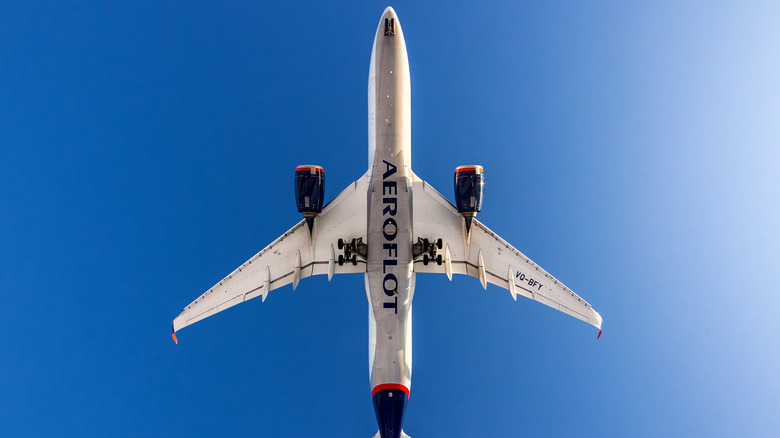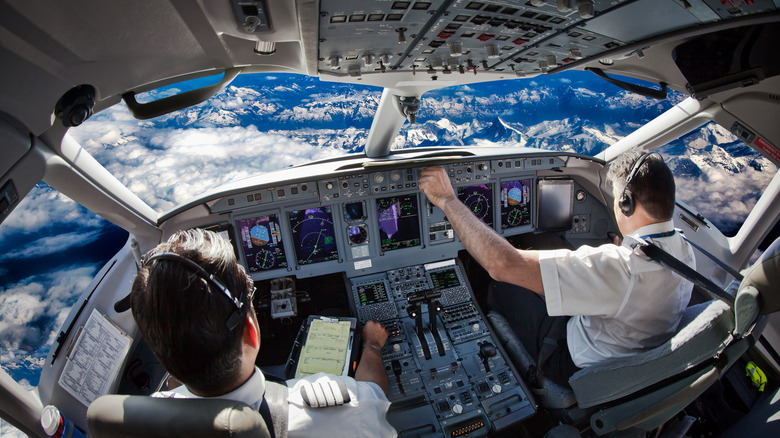The Innocent Choice That Caused The Deadly Crash Of Aeroflot Flight 593
We've all heard that planes are the safest way to travel, and that's true. EU Flight Compensation cites the risk of death from a plane crash as 1 in 11 million. Compare that with the vastly greater car crash death rate of 1 in 5,000. Put differently, NSC Injury Facts says that the fatal accident rate for commercial U.S. airlines is 0.0 — none — per 100,000 miles. To be clear: 100,000 miles equals four round trips around the Earth's fattest point, its equator. So everything you've heard about planes being safe? It's completely true. This is why plane crashes are such big news.
And yet, accidents do happen. The attorneys at the Wisner Baum — who among other things specialize in aviation accidents — cite a variety of typical reasons that plane accidents occur, like pilot error, mistakes by air traffic control, mechanical failures, and weather trouble. Sometimes these reasons are egregious to the point of unbelievable, like in the 2023 case of a ATR-72 Yeti Airlines plane landing at Pokhara Regional International Airport (VNPR) in Nepal, Tibet. As Aerotime says, the plane didn't have any "functioning instrument landing system" whatsoever.
Other times, such as in the case of Aeroflot Flight 593 in 1993, the reason for the crash was as tragically senseless as it was utterly preventable. All it took was one child hitting one switch by mistake mid-flight.
In the hands of a child
Simple Flying tells the whole, horrific story about what happened to Aeroflot Flight 593, starting with a practice that was common for the time and is sometimes still allowed: visits to a plane's cockpit. If this idea makes the hackles on the back of your neck rise, you're not alone.
Aeroflot was, and is, Russia's state-owned national airline. The plane that crashed — an Aeroflot Airbus A310 — had been in service for only about three months by the time it took to the skies on March 23, 1994 to head to Hong Kong from Moscow. As the story goes, relief pilot Yaroslav Vladimirovich Kudrinsky's children Eldar and Yana were on board and wanted to visit their father in the cockpit. Relief pilots, for the record, are fully-trained, regular pilots who substitute for main pilots and take over at certain points during flights.
Everything was fine until Kudrinsky demonstrated an incalculable lapse in judgement by letting his children handle the controls of the airplane. The autopilot was engaged, so minor movements to the plane's control column — the steering wheel-looking thing — didn't cause the plane to turn. Kudrinsky's son Eldar, however, yanked on the control column, which disengaged the autopilot. The whole plane started to bank right, but shockingly, none of the pilots apparently noticed — at least not right away. They didn't even see the flashing lights in the cockpit. By the time they regained control of the plane, it was too late.
A completely preventable tragedy
Virtual Globetrotting shows us the precise spot where Aeroflot 593 crashed in the Kuznetsk Alatau mountains of Russia northwest of Mongolia. All 63 passengers and 12 crew members died, including Yaroslav Vladimirovich Kudrinsky and his children who wanted to visit their father at work.
An archived 1994 article from The New York Times discusses excerpts from Aeroflot 593's cockpit voice recorder. The beginning of the end came when Kudrinksky's daughter Yana asked her father, "Daddy, can I turn this?" Kurdrinsky lets her do so, but tells her not to push any buttons. He also explains the city lights below and starlight above. Kudrinksky's son Eldar apparently grabs the control column of his own accord, and his dad yells at him. A full four minutes passes before Eldar asks, "Why is it turning?" and his father replies, "It's turning by itself?" Only then does a co-pilot realize what's happening. The pilots spend the next couple of minutes trying to right the plane even as it spirals into a nosedive. They apparently do regain control at 1,300 feet above the ground, but it was too little, too late. You can listen to the original recording on the Dark Records YouTube channel.
Simply Flying says that it was against regulations for Kurdrinsky to let his children handle the plane's controls, and that the plane experienced no technical faults at all. Everyone on board paid the price, and their deaths serve as a warning to the rest of us.


